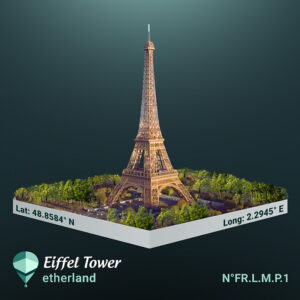 The French architect and engineer Gustave Eiffel, who also designed the Statue of Liberty, built the Eiffel Tower in 1889. Standing 324 meters tall, it is one of the most famous buildings in the world and a symbol of Paris, the capital of France. La Tour Eiffel in French language is one of the most visited monuments in the world and represents France in a simple symbol.
The French architect and engineer Gustave Eiffel, who also designed the Statue of Liberty, built the Eiffel Tower in 1889. Standing 324 meters tall, it is one of the most famous buildings in the world and a symbol of Paris, the capital of France. La Tour Eiffel in French language is one of the most visited monuments in the world and represents France in a simple symbol.
The Eiffel Tower is part of the history of Paris, and it is essential to know that its construction followed various steps. Built in two years by Gustave Eiffel and his collaborators, it has become the symbol of the French capital.
The Eiffel Tower was built as the entrance and gate to the 1889 World’s Fair on the site of a former train station in the heart of Paris. The three collaborators behind this technological masterpiece of architecture, Maurice Koechlin, Émile Nouguier, and Gustave Eiffel, finally named the Tower after Gustave.
Eiffel had initially planned twelve months of work. However, the construction phase began on January 28, 1887, and was finally completed in March 1889, just before the opening of the Universal Exhibition. The primary material of the tower, puddled iron, was chosen mainly because of its structural properties. A large part of the work was carried out upstream in the Eiffel factories in Levallois-Perret. As a result, there were not over 250 workers on site.
Thanks to its conception, Eiffel thought that his tower could serve science. In 1889, he agreed with the central meteorological office of France to install a tiny observation and measurement station at the top of the tower. Captain Ferrié, who is nowadays considered the pioneer of broadcasting, sought in 1903 to establish a wireless telegraph network without Army funding. Eiffel was able to finance part of his project and subsequently accepted the installation of an antenna at the top of his tower. The experience was a success and a strategic asset during the First World War.
It was used mainly for military purposes until 1920, so a will arose to move it to civilian use. Over the years, the techniques improved, making it possible from 1935 to offer TV shows. However, it was not publicly operational until 1959, when a new broadcasting mast installed enabled 10 million people to enjoy television.
Though its success at the Universal Exhibition in 1889 made it famous, the number of visitors remained steady until the end of the Second World War. However, thanks to the boom in international tourism, the number of visitors has steadily increased.
If you are staying in Paris, visiting the Eiffel Tower on a day trip to the city is highly recommended. You can even book a local walking tour, including a two-hour guided tour of the Eiffel Tower and the surrounding landmarks, or even a whole day. Visitors will receive headphones and a tablet to understand the history behind and around the tower. Its restaurants, located on the 1st and 2nd floors, offer different menus, one refined and the other more gastronomic. There is also a bar on the 3rd floor, enabling visitors to enjoy a large variety of drinks while surrounded by stunning views over the capital.